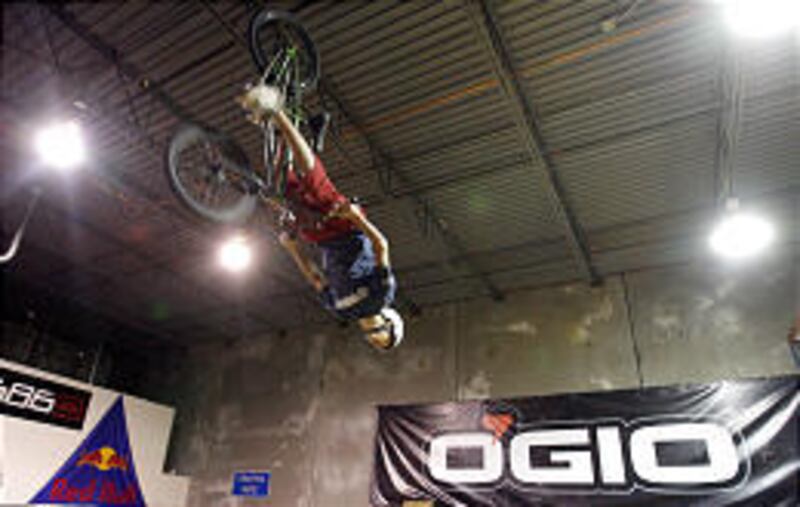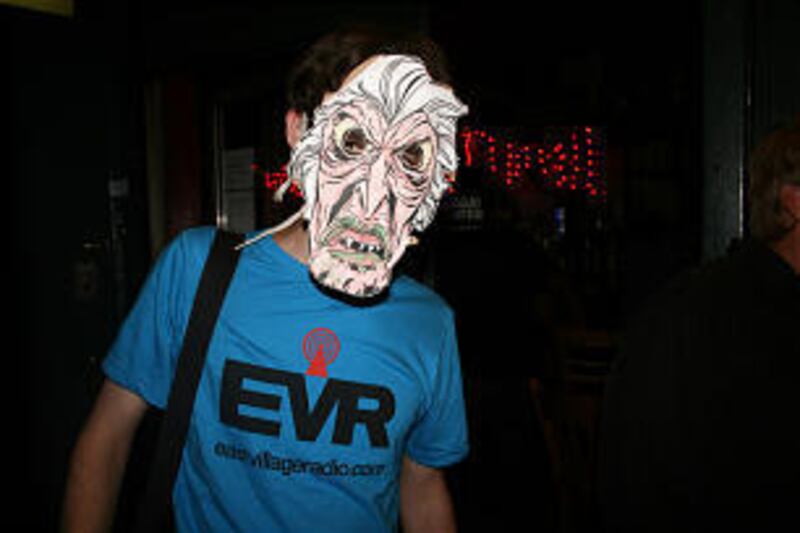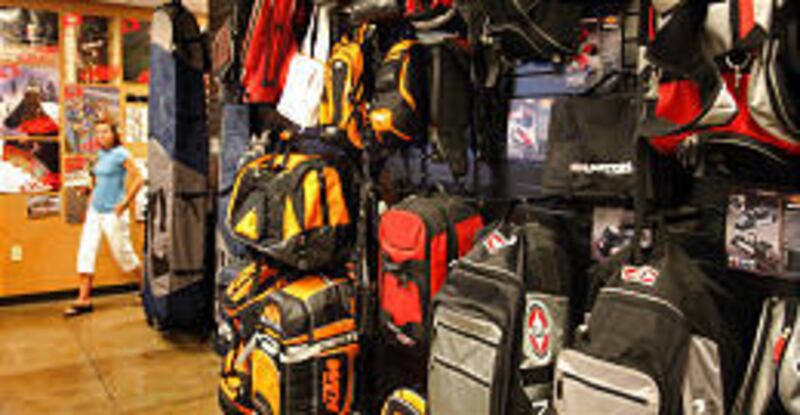Sure he's got the big house on the hill and the snowmobiles and the motorcycles and the Jet Skis and the weekly flying lessons and a wife and four kids and a Utah-based company called Ogio that has gone global and cracked a market dominated by Nike and Callaway and the other big boys, but it isn't easy being Michael Pratt.
He can't turn off his brain. From the mundane to the grandiose, his head is buzzing with ideas 24/7. Ideas for businesses, ideas for products, ideas for fixing up the yard, ideas for better light fixtures, ideas for designing a better golf bag, ideas, ideas, ideas. Even on vacation he doesn't get a vacation, it being difficult to leave your brain at the office.
He was trying to relax on the beach in Hawaii recently with his family, but his mind was thinking about how he could provide services on the beach and how to make the beach a better place to play. Later, he was driving around the island and couldn't find a convenience store, which prompted him to wonder if he should open a convenience store and how he would go about doing that. Then he went to a surf shop, where he started to think about how he could improve the shop.
"It's a blessing and a curse," says Dave Wunderli, president of Ogio and Pratt's longtime friend. "He's told me several times that he'll go for a walk with his wife and can't shut it off. Suddenly he's saying, 'Those people shouldn't have planted that tree there; in a few years it will block that view.' "
Pratt was working out at a local athletic club when the shape and design of the exercise equipment caught his eye. He called his design team to take pictures of the equipment and applied the designs to other, unrelated products.
Which is how his mind works. He got the idea for the design of the club holder in the Ogio golf bag from the lines and molded shape of the BMW automobile. He was so smitten with the mechanics and material on a pair of ski boots that he is applying both in the creation of luggage. Similarly, he has applied the shape and lines of motorcycles and airplanes to athletic bags.
Nothing seems to escape Pratt's attention. He was in a Denver restaurant with his family when the design of the condiment bar, of all things, caught his eye. He took pictures while the kids groaned. Not again.
"I'm sick," says the 45-year-old Pratt.
On the other hand, his sickness has made him wealthy. It was his sickness that caused him to invent a better gym bag because his own bag wouldn't fit in a locker. That was the beginning of Ogio, which makes bags for travel, sports, golf, motocross, snowboard, baseball, skateboarding, surfing, laptops and school.
Who knew the world needed another gym bag? Ogio has experienced 20 percent annual growth in sales five consecutive years and has expanded into most countries in South America, Europe, Asia, as well as Australia and Canada.
Meanwhile, Pratt has started two other companies — You-D, which produces personalized 3-D images of family and friends in the form of busts that are etched inside plastic cubes; and AK Designs, which makes new-age chairs.
Who knew the world needed another chair? Circuit City, Best Buy and Costco sell the AK chairs and, impressed by their look and design, some of those stores have made specific requests for an AK office chair. In 2 1/2 years AK has grown into a multimillion-dollar business.
As always, Pratt has turned his mind loose on the idea. He saw a display of chair bases during a visit to a factory in Asia and decided they were boring. After some research, he produced chair bases that look like automobile wheels.
"Mike's mind just never stops," says Ogio CFO Gary Bowen.
Pratt has always been intrigued by design and innovation. It was part of his metamorphosis from a drug-abusing, aimless youth to wealthy entrepreneur, family man and bishop in The Church of Jesus Christ of Latter-day Saints.
"Everything he sees, he tries to think of how it could be better," says his wife, Jana.
As a teenager, he decided that standard bike reflectors could be better, so he built a prototype in which the outer edge spun like a fan to create better reflection.
"He solves problems," says Wunderli. "That's what his head does."
This is vintage Pratt: The other day he wondered aloud why cell phones don't include a notch to allow easier access for a finger to open them.
"He rarely lets his mind be at ease," says Jana. "He constantly evaluates. I ask him to stop, for his sake, so he can relax."
Jana knew what she was getting into at the outset of their marriage. Many of their early dates consisted of her sitting in a cold garage watching him construct a prototype for one of his first creations: a cup holder for cars (which didn't exist at the time). It was a spring-loaded, retractable device that mounted on the door.
He built it out of strips of plastic and hinges. The idea caught the attention of executives of major corporations. At 19, he flew to meetings with McDonald's and Nissan, but he couldn't get what he considered a fair offer. He flew to Hong Kong to make another sales pitch. He didn't get the offer he wanted there either, but one company did offer him a job; they thought he was an engineer, but he hadn't even been to college. He wound up selling the cup holder to a company in New York.
"I'd see it in auto magazines, and then it fizzled out," he says. "Then they started putting cup holders in cars."
As a young teen, Pratt told anyone who would listen that he was going to invent things someday, but meanwhile he was flunking out of school. He barely graduated from high school.
"I was just a big daydreamer," he says.
He grew up in what he calls a dysfunctional home. His father, Jim, was a hard-living Green Beret. The family lived in 15 homes before Pratt graduated from high school. Jim Pratt died of cancer when Mike was 11. With money tight, Pratt, his mother, Darlene, and his two sisters lived in rented houses, apartments and, during one summer, a cabin. He remembers his nightstand was a cardboard box with a towel on it, and the family's yard was a mess, which today would be unthinkable for the meticulous Pratt.
"I had little parental guidance," says Pratt. "I was the kid that when everybody else had to go in at night, I was still out there. I'd go home because no one else was there. She was a wonderful mom, but life was overwhelming for her."
Pratt began working at a young age. After school, he rode the bus each day from Holladay to downtown Salt Lake City to perform janitorial services in a department store. He also mowed lawns, shoveled driveways, worked construction and, in high school, worked in the ski department at Sunset Sporting Goods. In what would become his hallmark, Pratt soon took over the design and layout of the store.
"Of course, he immediately had ideas on how to improve the ski department," recalls Wunderli. "He hung a mannequin upside down from the ceiling so it looked like he was doing a flip."
While attending Cottonwood High School, Pratt fell in with the party crowd. He drank heavily, free-based cocaine and dropped acid. He and his pals smoked so much dope, they bought it by the pound.
"He was very charismatic," recalls Wunderli, a classmate who ran in different circles but knew Pratt. "He was the kind of guy that girls just flocked to him because he was very random and confident and funny and had this wild side to him. He was one of those guys the guys wanted to be like. He was different than most of those guys were going to be who were stuck in the drug life. You knew if he ever got off drugs he would accomplish a lot."
After graduation, Pratt held various jobs, washing dishes in a restaurant and selling cars and insurance. "I wondered who I wanted to be," he says. "I wanted to be something."
The first books he ever read were an insurance manual and a science fiction novel that one of his peers urged on him. He became an avid reader. He began to read business magazines — Forbes, Fortune — and eventually success books. He was a devotee of Zig Ziglar.
"I began to think about my life and the direction I was headed," he says.
That led him to religion. He began reading scriptures and, at 20, decided to serve a two-year mission for the LDS Church (to Scotland).
"Everybody was shocked," he says.
Says Wunderli, "He had to walk away from every friend he had. It was tough. He got a lot of pressure from his buddies. He couldn't get away from that life if he was hanging out with them."
When he returned from his mission, Pratt married Jana. He was $15,000 in debt at the time, which is what he owed patent attorneys from the cup-holder project. He had to borrow money from Jana to buy a wedding ring.
"Her parents didn't want us to marry," he says. "She bought everything. She had a job and insurance, and I had nothing."
Jana was from a traditional, blue-collar family in which the father went to work in the morning and came home in the evening. Pratt stayed home and baby-sat their first child, Josh, while Jana went to work at a phone company. They lived in a friend's basement the first six months of their marriage.
"I had to accept the fact that he couldn't work for anyone," says Jana. "It was not easy. It took awhile to realize this was not just a phase, that he was not going to make a quick buck and be done. It's in his blood; he can't stop."
One day in 1986 Pratt went to the gym and was frustrated that his gym bag didn't fit into the locker unless he stood it on end. Using cardboard and duct tape, Pratt constructed a prototype of a bag designed to look and function like a miniature locker that could stand on end inside a gym locker. The bag opened like a locker door to reveal shelves inside.
Pratt called old contacts he had made in the Far East from the cup holder experience and found a manufacturer for the prototype in Hong Kong. He paid for a patent, and neighbor Paul Taggart fronted $10,000 to get the company started. Pratt ordered more than 4,000 of the bags to be shipped to Utah. Footlocker agreed to test market the bag for Christmas 1987. Soon, ZCMI and Nordstrom, among others, began to sell it.
About a year later, Dick McGillis, who made his fortune in sporting goods stores (young Pratt was one of his employees), agreed to pay off other investors and financed the operation.
"From there we grew it nationally," says Pratt. "Department stores went nuts with it."
Ogio was born. The name came during a brainstorming session with Jana, in which she began tossing out acronyms she had learned at the phone company. She suggested O.G.O., which stood for an "outgoing-only" line in telephone jargon. Pratt suggested the addition of the "I."
"The name doesn't mean anything," says Pratt. "We've always laughed about that."
Remarkably, Ogio was able to take on shoe companies like Nike that had a stranglehold on the market. The company also carved out its own niche by marketing itself for the extreme-sports crowd, producing specialized carry bags for motocross, surfing, BMX bike racing, skateboarding and snowboarding (there are motocross and BMX tracks on the grounds of the company headquarters).
"Extreme sports feels more like Ogio," says Pratt. "We're not marketing to younger people but to the young at heart."
Pratt also was bold enough to challenge the titans in the saturated golf market, although from the outset he was greeted with plenty of skepticism: You're nuts. Who needs another golf bag? You have no experience going into that world.
Now, Ogio is one of the leaders in golf bags after only seven years in the field.
"I saw room for innovation," says Pratt. "It allowed me to do what I love doing: Design."
He produced bold new shapes and color schemes for a staid sport — lime green, red and yellow, orange and blue, even camouflage — and new innovations such as "stadium seating" for the clubs and a "putter pit," which is now copied by other companies (Ogio says it is fighting this); a zipperless ball pocket; and the so-called "schling."
After seeing that most golfers carry their bags with one strap worn over one shoulder rather than go to the trouble of slipping both shoulders into the backpack-style straps, Pratt created a device that slips over both shoulders in one movement, like a pair of shoulder pads.
"I relish design," Pratt says. "I am obsessed by it."
On the corner of his desk is a design magazine. He has been waiting anxiously to thumb through it. "Design magazines are like a Christmas gift for me," he says. "I can't wait to open it. I can get nutty about this stuff."
Maybe this penchant for design and innovation is to be expected from the great-great-great-grandson of Orson Pratt, a famous Mormon pioneer, mathematician and scientist who co-designed a wooden odometer that was placed on a wagon coming across the Plains to Utah. He later laid out the famous block design of Salt Lake City.
"Maybe that's where it comes from," says Pratt, who has a drawer filled with nothing but ideas he has for future products.
Pratt designed his house, which sits on South Mountain overlooking the Salt Lake Valley. He worked on the plans in the evening after work. He also decorated most of it, picking out everything from the furniture to the air-conditioning vents, which he spotted in a California airport. Among other things, he has decorated the house with a giant hollowed-out tree fashioned into a vase and a 15-foot wooden propeller.
Intense and energetic, Pratt doesn't watch TV, doesn't follow sports, couldn't tell you who played in the last Super Bowl and could barely name a movie star. The other day he came home from work after listening to talk around the office and asked his wife, "Who is Angelina Jolie?"
Sitting in his new-age office, housed in a building that looks like the inside of the Starship Enterprise, Pratt turns to the future, as he is wont to do.
"My ultimate dream for work is to build a design center that creates innovative products and companies," he says. "They design; that's all they do. They'll spawn companies or enhance them. Each department will work with a specific business under the umbrella, but they'll work together."
And then he takes a pen and paper and begins to sketch the organizational chart excitedly, his mind racing away again with another idea.
E-mail: drob@desnews.com




